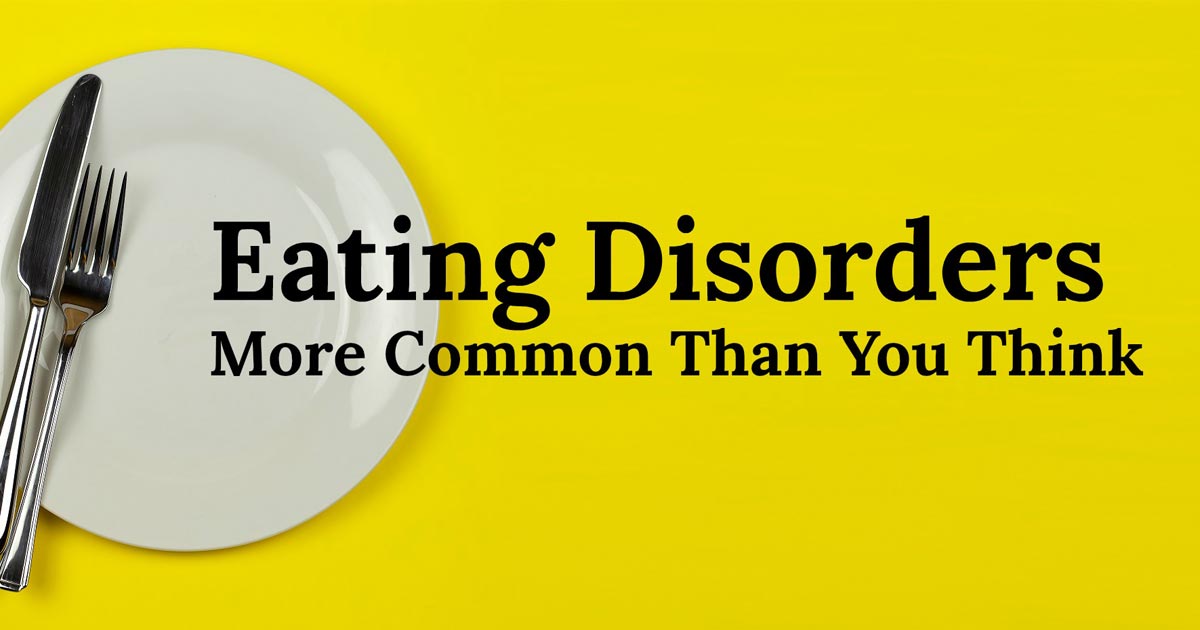Although roughly 30 million people in the U.S. are affected by eating disorders, most of us don't know much about these diseases. First, let's tackle a few of the myths with some facts.
Eating disorders are not a lifestyle choice; they are mental-physical illnesses.
Eating disorders affect individuals of every age, race, ethnicity and gender.
Eating disorders severely affect a person's eating behaviors, physical and mental health, and are sometimes fatal. Potential health consequences are heart attack, kidney failure, osteoporosis and electrolyte imbalance. A majority of individuals with eating disorders have a primary substance use (addiction) and/or mental health disorder, such as an anxiety, depression, obsessive-compulsive disorder or post-traumatic stress disorder, as well as a higher rate of self-harm, suicidal ideation and suicide attempts.
| Disorder | Prevalence in Average Population1 | Prevalence in Individuals with ED2 |
| Major Depressive Disorder | 6.7% | 32-50% |
| Anxiety Disorder (any) | 19.1% | 48-81% |
| Obsessive Compulsive Disorder | 1.2% | 33-69% |
| Post-Traumatic Stress Disorder | 3.6% | 38-44% |
| Substance Use Disorder | 8.4% | 50% |
Eating disorders are treatable. The sooner an eating disorder is detected, the better the chance for recovery.
Parents do not cause eating disorders and should not be blamed. Although the exact causation is not known, all eating disorders involve a range of biological, psychological and sociocultural issues.
Who is at risk for developing an eating disorder?
Eating disorders develop differently in different people. However, research shows similarities in major risk factors.
- Dieting.
- Perfectionism.
- Family history of eating disorder or obesity.
- Affective illness or alcoholism in first-degree relatives.
- Ballet, gymnastics, modeling, aesthetic sports that emphasis being thin, as well as professions that emphasis weight and body.
- Difficulty expressing emotions, particularly negative emotions such as anger, sadness, anxiety, shame, or fear.
- Parental eating behavior and weight.
- Physical or sexual abuse.
- The cultural value placed on thinness as a part of beauty, over focus on the body and diet.
- Media and social culture's unrealistic portrayal of people's shapes and bodies.
- Low self-esteem.
Types of Eating Disorders
There are several different types of eating disorders. The most prevalent are binge eating disorder, bulimia nervosa and anorexia nervosa.
The most common eating disorder in the U.S., binge eating disorder (BED) is characterized by recurrent episodes of eating large quantities of food often quickly and to the point of discomfort accompanied by a feeling of loss of control over this behavior. Afterwards, the person feels shame, distress or guilt.
Bulimia nervosa (BN) is characterized by a cycle of binge eating, followed by a cycle of compensatory behaviors such as inducing vomiting, excessive exercise or other behaviors to compensate for the binge eating. An individual struggling with bulimia will experience a disruption in their view of one's body weight or shape, potentially influenced by self-evaluation that is distorted.
People with anorexia nervosa (AN) generally restrict the number of calories and the types of food they eat. The main symptom is extreme weight loss due to food restriction, even starvation. Children and teens may not meet appropriate weight and height expected for their age. Limiting nutrients has serious medical consequences including disease of the cardiovascular, gastrointestinal, neurological and skeletal systems. Young people between the ages of 15 and 24 with anorexia have 10 times the risk of dying compared to their same-aged peers.
Warning Signs
The symptoms of each disorder can differ greatly, but some commons signs include:
- Weight fluctuations, not just weight loss. Being thin is not always a symptom. A person with BED or BN may not actually lose weight. A larger person with AN might not ever be thin.
- Intense fear of gaining weight.
- Preoccupation with food, calories, dieting, exercise, weight, etc.
- Unusual eating habits, eating in secret, cutting out food groups.
- Going to the bathroom immediately after eating.
- Frequent weighing.
- Body dissatisfaction and/or distorted body image.
- Gastrointestinal issues.
- Dressing in layers, easily cold.
- Dizziness, fatigue, dehydration.
- Bradycardia (slower than normal heart rate).
- Withdraws from social activities.
- Irritability and sensitive to criticism.
- Loss of period.
See the National Eating Disorders Association (NEDA) website for a comprehensive list of eating disorders and symptoms.
A Team Approach to Treatment
Taking a team approach to treatment of an eating disorder provides the best opportunity for long-term recovery. The treatment team may include physician, nutritionist, individual therapist and family therapist and, of course, YOU!
A mental health provider (psychologist or social worker) can help address the eating disorder as well as any co-occurring mental disorder. Several different forms of individual and group therapy have been found to help with recovery, including:
- Cognitive Behavioral Therapy. Self-monitoring of food and behavior, challenge thoughts and beliefs, learning how to experience and manage feelings, increase flexibility, exposure to food exercises. Recovery Record is a great free app to help with this.
- Dialectical Behavioral Therapy. Can be very helpful for Binge Eating Disorder and Bulimia. Helps teach emotion regulation skills, distress tolerance, mindfulness, and interpersonal relationship skills.
- Motivational Enhancement Therapy.
- Experiential therapies like art therapy, music therapy, and equine-assisted therapy.
- Mindfulness practices.
- Inpatient and residential programs. Specifically, for behaviors that can't be managed in the home, as well as those in need of re-feeding and more care due to physical consequences of their eating disorder
Getting Help for a Child
If you suspect a problem in a child or teen, take it seriously and get help as soon as possible! See your pediatrician or doctor to get an accurate weight and height, do a complete physical exam and order basic labs like CBC, full metabolic panel and electrocardiogram.
Validate your child's difficulties. Show you understand by listening carefully to what your child says, but still set the expectation to eat three meals. Establish regular scheduled meals as a family with all family members present at the table. Refuse to discuss calories, how much food you are eating, and don't lecture your child—simply set the expectation that eating is a non-negotiable. As a parent, separate your child from the illness. Be compassionate. Their negative beliefs about their body and food may be a consequence of starvation and may not present as rational, but they believe this.
Psychologists have seen that children recovery more quickly when the whole family is involved in treatment. Parents need to model healthy, non-judgment about their bodies! For example, if a teen is hearing mom or dad constantly talking about their need to diet, recent fad diet and/or hear parent say, "I gained so much weight over the holidays, I'm so fat!" ... it sends them a message to be more body conscious because their parent is judging their own shape.
Practice some debunking of diet culture and the media. Ask the challenging questions and remember, diet culture sells—it's selling a new fad diet, workout equipment and gear, a new quick trick. Have conversations about culture, the media and what it looks like to filter out the messages being sent to us to "conform." Adolescents struggle with a healthy sense of self and tend to rely on what peers focus on and the media, especially pro-anorexia (pro-ana) websites, blogs, chat rooms and social media that support practices like anorexia and bulimia.
Kelly Boprie, LMSW, is a clinician at the Pine Rest Southwest Clinic. She earned her Bachelor of Arts in Psychology and Sociology from Calvin College in 2005 and her Master's in Social Work from Grand Valley State University in 2009. Kelly aims to create a safe, supportive, empathic and validating environment for the clients that she sees. She utilizes cognitive behavioral therapy, trauma focused cognitive behavioral therapy, dialectical behavior therapy, acceptance commitment therapy, exposure response prevention therapy and supportive therapy. She has particular interest working with individuals who are struggling with eating disorders, body image concerns, trauma, sexual abuse and spiritual issues. She is working on Certified Eating Disorders Specialist (CEDS) certification through the International Association of Eating Disorders Professionals.
SOURCES:
1. National Institute of Mental Health
2. National Eating Disorders Association




